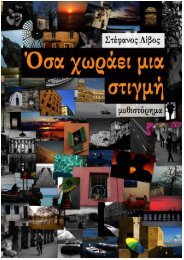- Page 2 and 3:
938 H45anHeeren64-11691Ancient Gree
- Page 7 and 8:
ANCIENT GREECE.TRANSLATED FROM THE
- Page 9 and 10:
THE TRANSLATOR'S PREFACETO THE FIRS
- Page 11:
GENERAL PRELIMINARY REMARKS.To the
- Page 14 and 15:
XPUEUMINAllY REMARKS.Europe belongs
- Page 16 and 17:
ilELIMINARY EBMAEKS.boon removed to
- Page 18 and 19:
2 ANCIENT GREECE.[ciur. i.Nature he
- Page 20 and 21:
4 ANCIENT GREECE. LCIXAP. I.distanc
- Page 22 and 23:
6 ANCIENT GREECE. [CHAP. i.territor
- Page 24 and 25:
8 ANCIENT GREECE* [OUJLT?. i,by gre
- Page 26 and 27:
10 ANCIENT GKEECE. [CHAP. I.afforde
- Page 28 and 29:
12 ANCIENT GREECE. [CHAP. i.the nob
- Page 30 and 31:
H ANCIENT GBEECE. [CHAP. I.lay at t
- Page 32 and 33:
"16 ANCIENT GREECE. [CHAP, Lmountai
- Page 34 and 35:
18 ANCIENT GEEECE. [
- Page 36 and 37:
'SO ANCIENT GEEECB. [CHAP. i.be fre
- Page 38 and 39:
[CHAP,%% ANCIENT GBEECE,,n.most pow
- Page 40 and 41:
24 ANCIENT GHEECE. [CHAP, u,entirel
- Page 42 and 43:
26 ANCIENT OEEECE. [CHAP, ui.to tho
- Page 44 and 45:
28 ANCIENT GREECE. [CIUF. m.the ear
- Page 46 and 47:
30 ANCIENT GREECE. [CHAP. m.lay at
- Page 48 and 49:
'83 ANCIENT GBEECE. [u*. m.these vi
- Page 50 and 51:
34 ANCIENT GREECE, [CHAP. m.nation
- Page 52 and 53:
36 ANCIENT GREECE. [CHAP, inpresent
- Page 54 and 55:
88 ANCIENT GREECE. [OHA*. ni.The sy
- Page 56 and 57:
40 ANCIENT GREECE. [CHAP. m.them wa
- Page 58 and 59:
ANCIENT GREECE.chosen bylot. 1 Tho
- Page 60 and 61:
ANCIENT GKKKCK. [CHAP, in.separate
- Page 62 and 63:
ANCIENT GREECE. [niur. nr.place in
- Page 64 and 65:
48 ANCIENT GRBECE. [CHAP. in.althou
- Page 66 and 67:
50 ANCIENT GREECE, [CHAP. 17.CHAPTE
- Page 68 and 69:
52 ANCIENT GBEECE. [ciur. iv.to be
- Page 70 and 71:
ANCIENT GREECE.[CHAP.IV.in the inte
- Page 72 and 73:
56 ANCIENT GBEECE. [CHAP. iv.seemed
- Page 74 and 75:
58 ANCIENT GEEECE. [CHAP. iv.the en
- Page 76 and 77:
60 ANCIEOT GREECE. [CHAP. iv.other,
- Page 78 and 79:
62 ANCIENT GREECE.[ cnAP vCHAPTER V
- Page 80 and 81:
ANCIENT GREECE.[ciur. y.of Lesbos ;
- Page 82 and 83:
ANCIENT GKEECE."in most of them bet
- Page 84 and 85:
68 ANCIENT GREECE. [CHAP, vi,them,
- Page 86 and 87:
70 ANCIENT GREECE. LCIUP. vi.of the
- Page 88 and 89:
[CHAP.72 ANCIENT GREECE..vi.youth.
- Page 90 and 91:
74 ANCIENT GREECE. [CHAP, vr.We fin
- Page 92 and 93:
76 ANCIENT GREECE. [OHAP.YI.of thei
- Page 94 and 95:
78 ANCIENT GEEECB. [CHAP. TI,ally e
- Page 96 and 97:
50 ANCIENT GREECE, [CHAP. vn.pas en
- Page 98 and 99:
83 ANCIENT GREECE. [CHAP. vn.far as
- Page 100 and 101:
84 ANCIENT GREECE. [CHAP. vn.the mo
- Page 102 and 103:
86 ANCIENT GREECE. [CHAP. vix.The i
- Page 104 and 105:
88 ANCIENT GREECE. [CHAP. vir.becom
- Page 106 and 107:
80 ANCIENT GREECE. [CHAP, vn.body.
- Page 108 and 109:
92 ANCIENT GREECE. [CHAP, vn.measur
- Page 110 and 111:
94 ANCIENT GBEECE. [CHAP. vm.became
- Page 112 and 113:
96 ANCIENT GREECE. [CHAP. YIH,its o
- Page 114 and 115:
98 ANCIENT GREECE. [CHAP. vni.that
- Page 116 and 117:
100 ANCIENT GREECE. [OIIAP. vxn.con
- Page 118 and 119:
102 ANCIENT GREECE. [CHAP. vni.the
- Page 120 and 121:
104- ANCIENT GREECE. [CHAP, ix,CHAP
- Page 122 and 123:
106 ANCIENT GREECE. [CHAP. ix.the s
- Page 124 and 125:
108 ANCIENT GREECE. [CHAP. a ,right
- Page 126 and 127:
110 ANCIENT GREECE. [CHAP. tt .the
- Page 128 and 129:
ANCIENT GBEECE. [CHAP, ix,jects whi
- Page 130 and 131:
114: ANCIENT GREECE. [CHAP. JX .we
- Page 132 and 133:
116 ANCIENT GBEECE. [CHAP. 1X .fore
- Page 134 and 135:
118 ANCIENT GREECE.[CHAP. ix.mainta
- Page 136 and 137:
120 ANCIENT GREECE, [CHAP. ix.must
- Page 138 and 139:
ANCIENT GBEECE. [CHAP. ix.sensibly,
- Page 140 and 141:
124 ANCIENT GREECE. [CHAP, aIn a na
- Page 142 and 143:
5Compare on this subject, first of
- Page 144 and 145:
128 ANCIENT GREECE. [CHAP. x ,The f
- Page 146 and 147:
130 ANCIENT GREECE. [CHAP. x .of Ar
- Page 148 and 149:
L3 ANCIENT GREECE. [CHAK xsupply th
- Page 150 and 151:
134 ANCIENT GREECE. [CHAP. x .and r
- Page 152 and 153:
136 ANCIENT GREECE.[CHAP. x ,it sub
- Page 154 and 155:
ANCIENT GREECE. [CHAP. x.we learn,
- Page 156 and 157:
140 ANCIENT GREECE. [CHAP, x.belong
- Page 158 and 159:
148 ANCIENT GREECE. [CHAP. x.the co
- Page 160 and 161:
144 ANCIENT GREECE. [CHAP. x.rectly
- Page 162 and 163:
146 ANCIENT GREECE, [CHAP. XI.counc
- Page 164 and 165:
148 ANCIENT GREECE.- [CHAP. XI.time
- Page 166 and 167:
150 ANCIENT GREECE. [CHAP, xi,citiz
- Page 168 and 169:
ANCIENT GREECE.[CHAP. XLcome before
- Page 170 and 171:
ANCIENT GREECE.[CHAP. xu.enemies. W
- Page 172 and 173:
156 ANCIENT GREECE.[CHAP. xir.becam
- Page 174 and 175:
158 ANCIENT GREECE. [CHAP. x*n.was
- Page 176 and 177:
160 ANCIENT GREECE. [CHAP, MI.On th
- Page 178 and 179:
ANCIENT GREECE.[CHAP. xn.the comman
- Page 180 and 181:
164 ANCIENT GREECE. [CHAP. xn.drew
- Page 182 and 183:
166 ANCIENT GREECE. [CHAP, xmerous
- Page 184 and 185:
168 ANCIENT GEEECE. [CHAP. xn.the f
- Page 186 and 187:
1 ANCIENT GREECE. [CHAP. xii.whole
- Page 188 and 189:
172 ANCIENT GREECE. [CHAP. xn.Pelop
- Page 190 and 191:
174 ANCIENT GREECE. [CHAP.influenti
- Page 192 and 193:
176 ANCIENT GBEECE. [CHAP. xin.mand
- Page 194 and 195: 4 Plutarch. Op. iii. p. 202. 5 Call
- Page 196 and 197: 180 ANCIENT GREECE.[CHAP. xin.in al
- Page 198 and 199: ANCIENT GREECE.[CHAP. xm.suffered t
- Page 200 and 201: 184 ANCIENT GREECE. [CHAP. xm.we ca
- Page 202 and 203: 186. ANCIENT GREECE. [CHAP. xm.resu
- Page 204 and 205: 188 ANCIENT GREECE. [CUA.P. xin.in
- Page 206 and 207: 190 ANCIENT GIIEECE. [CHAP. xin.suc
- Page 208 and 209: "ANCIENT GREECE. [CHAP, xiyhas the
- Page 210 and 211: The194 ANCIENT GBEECE. [CHAP, xiv,t
- Page 212 and 213: 196 ANCIENT GBEECE. [CHAP. xiv.alt
- Page 214 and 215: * In Themistocles, Op. i. p. 440. *
- Page 216 and 217: 200 ANCIENT GREECE.[CHAP. xiv.dange
- Page 218 and 219: 202 ANCIENT GREECE.the higher class
- Page 220 and 221: 20-i ANCIENT GREECE.[ CHJLP. xiv.in
- Page 222 and 223: 206 ANCIENT GREECE. [CHAP. XIV.requ
- Page 224 and 225: ANCIENT GREECE.[CHAP. xiv.And here
- Page 226 and 227: 210 ANCIENT GREECE. [CHAP. xiv.but
- Page 228 and 229: ANCIENT GREECE.[CHAT-, xrv.are so l
- Page 230 and 231: 214 ANCIENT GREECE.[CHAP. xiv.choic
- Page 232 and 233: ANCIENT GREECE.[CHAP. xiv.A sentime
- Page 234 and 235: 218 ANCIENT GREECE. [CHAP, xvBut ev
- Page 236 and 237: ANCIENT GREECE.[CHAP, xv.heroic age
- Page 238 and 239: ANCIENT GREECE,[CHAP. xv.and all th
- Page 240 and 241: 22 AKCIENT GREECE. [CHAP . xv,and s
- Page 242 and 243: ANCIENT GBEECE.[CHAP< xythat advant
- Page 246 and 247: 30 ANCIENT GREECE. [CHAP. xv.a dwel
- Page 248 and 249: ANCIENT GREECE.[CHAP. xv.inmany ins
- Page 250 and 251: ANCIENT GREECE.[CHA*. xv.of art are
- Page 252 and 253: #36 ANCIENT GREECE. [CHAP, xvi.stil
- Page 254 and 255: ANCIENT GEEECE.[CHAP. xvi.period, g
- Page 256 and 257: 40 ANCIENT GREECE. [CHAP. xvi.it co
- Page 259 and 260: AN INQUIRY INTOTHE POLITICAL CONSEQ
- Page 261 and 262: OF THE REFORMATION. 245stood to the
- Page 263 and 264: OF THE REFORMATION.S47zens, on whos
- Page 265 and 266: OF THE REFORMATION. 249our inquirie
- Page 267 and 268: OF THE BEFORMATION.few potentateswh
- Page 269 and 270: OF THE REFORMATION. 253standing the
- Page 271 and 272: OF THE REFORMATION. 55a struggle ;o
- Page 273 and 274: OF THE REFORMATION. 257pear in a mo
- Page 275 and 276: OF THE REFOKMATION. 259However litt
- Page 277 and 278: OF THE BEFORMATION. 261enced rather
- Page 279 and 280: OF THE REFORMATION. 263time* no one
- Page 281 and 282: OF THE REFORMATION. 265Elizabeth (1
- Page 283 and 284: OF THE REFORMATION. 267pearance of
- Page 285 and 286: OP THE REFORMATION. 69From the mids
- Page 287 and 288: OF THE REFORMATION.the Reformation
- Page 289 and 290: OF THE BEFORMATION.aristocracy than
- Page 291 and 292: OF THE EEFOEMATION. 275very dangero
- Page 293 and 294: OF THE REFORMATION. 277of these, fr
- Page 295 and 296:
OF THE REFORMATION, 79The same thin
- Page 297 and 298:
OF THE REFOBMATION. 281which itmigh
- Page 299 and 300:
OF THE REFORMATION.be directed to s
- Page 301 and 302:
OF THE REFORMATION. 85beyond the li
- Page 303 and 304:
OF THE REFORMATION. 287foundation-s
- Page 305 and 306:
OF THE REFORMATION. 289latter than
- Page 307 and 308:
OF THE REFORMATION. 91which had; in
- Page 309 and 310:
OF THE REFORMATION. 293certainly no
- Page 311 and 312:
OF THE REFORMATION.riority, which t
- Page 313 and 314:
OF THE REFORMATION.and France shoul
- Page 315 and 316:
,anyOF THE EEFORMATION. 299remain i
- Page 317 and 318:
OF THE EEFOBMATION. 01minds of the
- Page 319 and 320:
OF THE REFORMATION. 303gaged in cha
- Page 321 and 322:
OF THE BEFOBMATION. 305Were they no
- Page 323 and 324:
AS IT AFFECTED PHILOSOPHY. 007justl
- Page 325 and 326:
AS IT AFFECTED PHILOSOPHY. 309altho
- Page 327 and 328:
OF POLITICAL THEORIES. 311attribute
- Page 329 and 330:
OF POLITICAL THEORIES.SISlosophy. I
- Page 331 and 332:
OF POLITICAL THEORIES, 315ferent fo
- Page 333 and 334:
OF POLITICAL THEORIES.from being mu
- Page 335 and 336:
OF POLITICAL THEORIES. > 319country
- Page 337 and 338:
OF POLITICAL THEORIES.be found else
- Page 339 and 340:
OF POLITICAL THEORIES. 33questions
- Page 341 and 342:
OF POLITICAL THEOKIES. 325speculati
- Page 343 and 344:
OF POLITICAL THEORIES. 327According
- Page 345 and 346:
OF POLITICAL THEORIES. 39tion on wh
- Page 347 and 348:
OF POLITICAL THEORIES. 331It has ne
- Page 349 and 350:
OF POLITICAL THEORIES. 333political
- Page 351 and 352:
OF POLITICAL THEORIES. 335sophers a
- Page 353 and 354:
OF POLITICAL THEORIES. S-37nal rela
- Page 355 and 356:
OF POLITICAL THEORIES. 339will tell
- Page 358:
342 ON THE RISE, PROGKESS, ETC.boas
- Page 362:
M6ON THE RISE, PROGRESS, ETC.tertai
- Page 365 and 366:
OF POLITICAL THEORIES. 349ginal fre
- Page 367 and 368:
OF POLITICAL THEORIES, 351be genera
- Page 369 and 370:
OF POLITICAL THEORIES. 353rank. Not
- Page 371 and 372:
OF POLITICAL THEORIES. 355The idea
- Page 373 and 374:
OF POLITICAL THEORIES. 57own, other
- Page 375 and 376:
OP POLITICAL THEORIES. 359it be bet
- Page 377 and 378:
OF POLITICAL THEORIES. 361The voice
- Page 379 and 380:
INTERESTS OF GREAT BRITAIN. 363not
- Page 381 and 382:
INTERESTS OF GREAT BRITAIN. 365It i
- Page 383 and 384:
INTERESTS OF GREAT BRITAIN. 367are
- Page 385 and 386:
INTERESTS OF GREAT BRITAIN. 69Band
- Page 387 and 388:
INTERESTS OF GREAT BRITAIN, 371indu
- Page 389 and 390:
INTERESTS OF GREAT BRITAIN. 31of th
- Page 391 and 392:
INTERESTS OF GREAT BRITAIN. 375gene
- Page 393 and 394:
INTERESTS OF GREAT BRITAIN. 377diff
- Page 395 and 396:
INTERESTS OF GREAT BRITAIN. 379game
- Page 397 and 398:
INTERESTS OF GREAT BBITAIN. 881THIE
- Page 399 and 400:
INTERESTS OF GREAT BRITAIN. 83This
- Page 401 and 402:
INTERESTS OF GREAT BRITAIN. 385notw
- Page 403 and 404:
INTERESTS OF GREAT BRITAIN. 387niar
- Page 405 and 406:
INTERESTS OF GREAT BRITAIN. 389to h
- Page 407 and 408:
INTERESTS OF GREAT BRITAIN. 391shal
- Page 409 and 410:
INTERESTS OF GREAT BRITAIN.There is
- Page 411 and 412:
INTERESTS OF GREAT BRITAIN. 395once
- Page 413 and 414:
INTERESTS OF GREAT BRITAIN. 397nati
- Page 415 and 416:
INTERESTS OF GREAT BRITAIN. 399a pr
- Page 417 and 418:
INTERESTS OF GREA.T BRITAIN. 401lit
- Page 419 and 420:
INTERESTS OF GREAT BRITAIN. 403coul
- Page 421 and 422:
INTERESTS OF GREAT BRITAIN. 405fort
- Page 423 and 424:
INTERESTS OF GREAT BRITAIN. 407quir
- Page 425 and 426:
INTERESTS OF GREAT BRITAIN. 409poli
- Page 427 and 428:
INTERESTS OF GBEAT BRITAIN. 411birt
- Page 429 and 430:
INTERESTS OF GREAT BRITAIN. 413affe
- Page 431 and 432:
INTERESTS OF GREAT BRITAIN. 415said
- Page 433 and 434:
INTERESTS OF GREAT BRITAIN. 417repe
- Page 435 and 436:
INTERESTS OF GREAT BRITAIN. 419mona
- Page 437 and 438:
INTERESTS OF GREAT BRITAIN. 421The
- Page 439 and 440:
INTERESTS OF GREAT BRITAIN. 4231mai
- Page 441 and 442:
INTERESTS OF GREAT BRITAIN. 425tiat
- Page 443 and 444:
INTERESTS OF GEEAT BRITAIN.effected
- Page 445 and 446:
INTEBESTS OF GREAT BRITAIN. 439to c
- Page 447 and 448:
INTERESTS OF GREAT BRITAIN. 431inde
- Page 449 and 450:
INTERESTS OF GREAT BRITAIN. 433call
- Page 451 and 452:
INTERESTS OF GREAT BRITAIN,of Dresd
- Page 453 and 454:
INTERESTS OF GBEAT BRITAIN. 437term
- Page 455 and 456:
INTERESTS OF GREAT BRITAIN. 439joye
- Page 457 and 458:
INTERESTS OF GREAT BRITAIN. 441year
- Page 459 and 460:
INTERESTS OF GREAT BRITAIN. 443has
- Page 461 and 462:
INTERESTS OF GEEAT BRITAIN.of Utrec
- Page 463 and 464:
INTERESTS OF GREAT BRITAIN. 447to t
- Page 465 and 466:
INTERESTS OF GREAT BRITAIN.as the a
- Page 467 and 468:
INTERESTS OF GREAT BRITAIN. 451the
- Page 469 and 470:
INTERESTS OF GREAT BRITAIN. 453admi
- Page 471 and 472:
INTERESTS OF GREAT BRITAIN. 455assu
- Page 473 and 474:
INTERESTS OF GREAT BRITAIN, 457infl
- Page 475 and 476:
INTERESTS OF GREAT BRITAIN. 459he w
- Page 477 and 478:
INTERESTS OF GREAT BRITAIN. 461had
- Page 479 and 480:
INTERESTS OF GREAT BRITAIN, 463of a
- Page 481 and 482:
INTEKESTS OF GREAT BRITAIN. 465whic
- Page 483 and 484:
INTERESTS OF GREAT BRITAIN. 467when
- Page 485 and 486:
INTERESTS OF GREAT BRITAIN. 469dire
- Page 487 and 488:
INTERESTS OF GREAT BRITAIN. 471Basl
- Page 489 and 490:
INTERESTS OF GREAT BRITAIN. 473from
- Page 491 and 492:
INTERESTS OF GREAT BRITAIN. 475atta
- Page 493 and 494:
of success, asINTERESTS OF GEEAT BR
- Page 495 and 496:
INTEEESTS OF GREAT BRITAIN. 479the
- Page 497 and 498:
INTERESTS OF GREAT BRITAIN. 481was
- Page 499 and 500:
INTERESTS OF GREAT BRITAIN. 483cont
- Page 501 and 502:
INTEBESTS OF GREAT BRITAIN. 485But
- Page 503 and 504:
of France had succeededINTERESTS OF
- Page 505 and 506:
INTERESTS OF GREAT BRITAIN. 489than
- Page 507 and 508:
INTERESTS OF GREAT BRITAIN. 491but
- Page 509 and 510:
INTERESTS OF GREAT BRITAIN. 493only
- Page 511 and 512:
INTERESTS OF GEEAT BRITAIN. 495ceed
- Page 513 and 514:
INTERESTS BOF GREAT BRITAIN. 497Whe
- Page 515 and 516:
INTERESTS OF "GREAT BRITAIN. 499tha
- Page 517 and 518:
APPENDIX.(p. 449.)An Examination of
- Page 519 and 520:
APPENDIX. 503succession. It was fir
- Page 521 and 522:
APPENDIX. 505plements of war, may s
- Page 523 and 524:
APPENDIX. 507declared, that under t
- Page 525 and 526:
INDEXANCIENT GREECE.Acarnania, geog
- Page 527 and 528:
.heroicINDEX TO ANCIENT GREECE. 511
- Page 529 and 530:
Protagoras, 201.Pyrrho, 205.Pythago
- Page 531 and 532:
INDEX TO HISTORICAL TREATISES. 515"
- Page 533 and 534:
,PMlipINDEX TO HISTORICAL TREATISES
- Page 538:
1 08 5347]
















